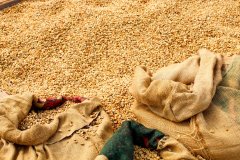What does cleanliness in coffee roasting mean?
In coffee roasting classes, people keep talking about how to find "clean" roasting, which is actually the most direct description of the preparation of different drinks and the criteria for judging the coffee beans used in their products. therefore, some people always ask, what does "clean" roasting mean?
Today, I hope to explain it in a more specific and visual way through this article, because when it comes to coffee, we must be able to understand the importance of "cleanliness" in different areas of the coffee industry.
The so-called "clean" roasting refers to the relatively complete retention of coffee flavor and aroma based on the origin, variety and processing characteristics of coffee beans.
It is well known that different degrees of roasting produce different chemicals, which in turn make the same batch of coffee beans show different flavors; chemical elements at different stages are produced in different temperature ranges.
This means that the more we understand the internal structure and chemical composition of raw beans, the more we can control the formation of flavor.
Generally speaking, if the temperature is not enough, the organic chemicals used to transform flavor and aroma cannot be fully decomposed, then chlorogenic acid will be maintained at a high level, that is, the astringency of coffee, the taste of grass or milk, and the sour taste.
If the roaster is overheated, the risk of forming a dry distillation chemical flavor will be increased, that is, rubber, smoky, bitter, spicy and charcoal flavor will be more prominent.
Sometimes, rapid baking at high temperature will result in the result that the outer surface of the bean is scorched but the central part is underbaked, in which case the two problems will occur at the same time.
If you can ensure strict implementation of raw bean sample baking standards, and have mastered mature cup testing techniques to make adequate preparations for "clean" baking, then the next thing you need to do is, try to balance or control the variables of all baking tools: speed, firepower, wind speed, weight, and use the right temperature at the right time according to different raw bean varieties and handling methods.
Important Notice :
前街咖啡 FrontStreet Coffee has moved to new addredd:
FrontStreet Coffee Address: 315,Donghua East Road,GuangZhou
Tel:020 38364473
- Prev

Treatment of raw coffee beans and fermented coffee by sun drying, honey treatment and washing
Many people enjoy coffee without thinking about why it is so delicious. Drinking coffee is more than just pouring coffee powder into the coffee machine and pressing the button. Coffee comes from a kind of fruit called coffee fruit. Coffee beans are actually the seeds of coffee fruits. People need to remove, dry and ferment the peel and pulp in order to get coffee beans, and then coffee beans will be roasted and packaged.
- Next
What does the cleanliness in coffee roasting mean the source of coffee astringency coffee bean roasting temperature and time
In the coffee roasting class, we keep talking about how to find clean roasting, which is actually the most direct description of the preparation of different drinks and the criteria for judging the coffee beans used for production, so some people always ask, what does clean baking mean? Today, I hope to explain it in a more specific and visual way through this article, because when it comes to coffee, we must be able to understand.
Related
- Beginners will see the "Coffee pull flower" guide!
- What is the difference between ice blog purified milk and ordinary milk coffee?
- Why is the Philippines the largest producer of crops in Liberia?
- For coffee extraction, should the fine powder be retained?
- How does extracted espresso fill pressed powder? How much strength does it take to press the powder?
- How to make jasmine cold extract coffee? Is the jasmine + latte good?
- Will this little toy really make the coffee taste better? How does Lily Drip affect coffee extraction?
- Will the action of slapping the filter cup also affect coffee extraction?
- What's the difference between powder-to-water ratio and powder-to-liquid ratio?
- What is the Ethiopian local species? What does it have to do with Heirloom native species?

